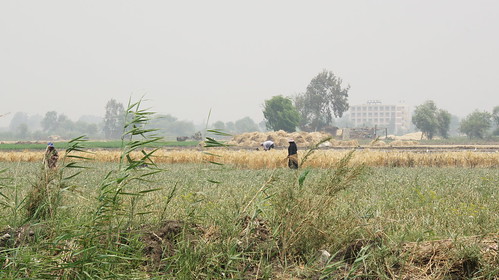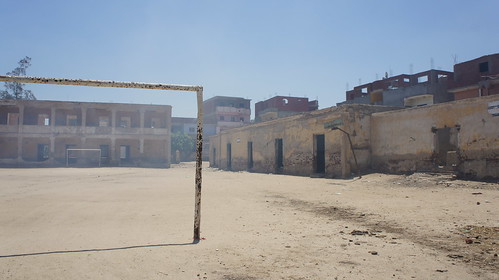There are more shocking numbers about Egypt's Countryside that were announced in 2015 and nobody cared to discuss them despite how much revealing they are just like the agricultural land ownership numbers.
In late December, Egypt's Central Agency for public mobilization "CAPMAS" issued a report about its complete survey in Egypt's countryside and its characteristics.
According to that survey, 75% of Egyptian villages do not have sewage systems.
Yes, 3/4 of villages in that survey conducted on 4655 villages across Egypt do not have access to a sewage system.
The report added that even in the rest 25% lucky villages with sewage system things are not that smooth.
According to CAMPAS' report, the sewage system in 47.5% of the villages that got them are either blocked or not working properly.
Those numbers are really quite interesting because we are speaking about a sample of villages, after all, not all the villages in Egypt or for instance, the shanty towns.
In an TV interview with CBC Extra channel earlier this week, the spokesperson of Egypt's Holding Company for Water and Wastewater Colonel Mohi El-Din El-Serafy "yes Col." stated that 85% of the villages in Egypt did not have real sweage system.
He added that his company needed LE 100 billion to set up sewage systems in all those villages.
I do not need to say that the lack of sewage system facilitates the spread of disease.
Now 66.3% of those villages need paved roads as according to the survey.
Nevertheless, there are good numbers in the survey ....somehow.
97.5% of the villages in the survey are connected to the public electricity network but 38.4% of those villages report a powercut every couple of days. "Powercuts are actually common in Upper Egypt".
96.5% of the villages in the survey are connected to the public network of water still 15.1% of those villages report water cutoffs on a daily basis while 37% of the villages witness water cutoffs on a weekly basis.
95.3% of the villages in the survey got primary schools and 82% of them have got preparatory schools.
Meanwhile, only 18.2% of the villages have got secondary schools.
Also, 59.4% of those villages need new schools.
There are pharmacies in 83.8% of the villages in the survey.
Only 69.7% of the villages have medical units "I do not have to guess the standard of the service there" while only 6% of those villages got a public hospital.
40.5% of those villages need also new medical units.
There are planned parenthood clinics in 51.5% of those villages. I can safely say that it did not stop the Egyptian farmers of having more and more children despite the billions spent on the Planned parenthood programme because simply farmers use their kids as extra hands n the fields thanks to poverty.
1/3 of those villages lack cultural center , bakeries and youth centers.
The CAPMAS survey was conduced in 4655 villages as follows : 12 villages in city governorates "Cairo and Giza" , 2700 villages in Nile Delta "Lower Egypt", 1754 villages in Uper Egypt and 189 villages in border governorates "Aswan , New Valley and Marsa Matrouth".
North and South Sinai governorates were not included in that survey.
If we have a true responsible media that is not afraid to ask , we should have an ongoing huge discussion regarding those numbers.
I see those numbers and I wonder where the millions if not billions we have always read about in the newspapers every year in the past 31 years in Egypt allocated for the infrastructure in villages are gone .
Already many of those billions were grants and loans from abroad and yet nothing change.

Again that survey is limited to a number of villages and not all villages of Egypt.
Sources : Ahram Online and Al-Mal
In late December, Egypt's Central Agency for public mobilization "CAPMAS" issued a report about its complete survey in Egypt's countryside and its characteristics.
According to that survey, 75% of Egyptian villages do not have sewage systems.
Yes, 3/4 of villages in that survey conducted on 4655 villages across Egypt do not have access to a sewage system.
The report added that even in the rest 25% lucky villages with sewage system things are not that smooth.
According to CAMPAS' report, the sewage system in 47.5% of the villages that got them are either blocked or not working properly.
Those numbers are really quite interesting because we are speaking about a sample of villages, after all, not all the villages in Egypt or for instance, the shanty towns.
In an TV interview with CBC Extra channel earlier this week, the spokesperson of Egypt's Holding Company for Water and Wastewater Colonel Mohi El-Din El-Serafy "yes Col." stated that 85% of the villages in Egypt did not have real sweage system.
He added that his company needed LE 100 billion to set up sewage systems in all those villages.
I do not need to say that the lack of sewage system facilitates the spread of disease.
Now 66.3% of those villages need paved roads as according to the survey.
Nevertheless, there are good numbers in the survey ....somehow.
97.5% of the villages in the survey are connected to the public electricity network but 38.4% of those villages report a powercut every couple of days. "Powercuts are actually common in Upper Egypt".
96.5% of the villages in the survey are connected to the public network of water still 15.1% of those villages report water cutoffs on a daily basis while 37% of the villages witness water cutoffs on a weekly basis.
95.3% of the villages in the survey got primary schools and 82% of them have got preparatory schools.
Meanwhile, only 18.2% of the villages have got secondary schools.
Also, 59.4% of those villages need new schools.
 |
| An abandoned school in Faqoos, Sharkia |
Only 69.7% of the villages have medical units "I do not have to guess the standard of the service there" while only 6% of those villages got a public hospital.
40.5% of those villages need also new medical units.
There are planned parenthood clinics in 51.5% of those villages. I can safely say that it did not stop the Egyptian farmers of having more and more children despite the billions spent on the Planned parenthood programme because simply farmers use their kids as extra hands n the fields thanks to poverty.
1/3 of those villages lack cultural center , bakeries and youth centers.
The CAPMAS survey was conduced in 4655 villages as follows : 12 villages in city governorates "Cairo and Giza" , 2700 villages in Nile Delta "Lower Egypt", 1754 villages in Uper Egypt and 189 villages in border governorates "Aswan , New Valley and Marsa Matrouth".
North and South Sinai governorates were not included in that survey.
If we have a true responsible media that is not afraid to ask , we should have an ongoing huge discussion regarding those numbers.
I see those numbers and I wonder where the millions if not billions we have always read about in the newspapers every year in the past 31 years in Egypt allocated for the infrastructure in villages are gone .
Already many of those billions were grants and loans from abroad and yet nothing change.

Again that survey is limited to a number of villages and not all villages of Egypt.
Sources : Ahram Online and Al-Mal

No comments:
Post a Comment
Thank You for your comment
Please keep it civilized here, racist and hateful comments are not accepted
The Comments in this blog with exclusion of the blog's owner does not represent the views of the blog's owner.